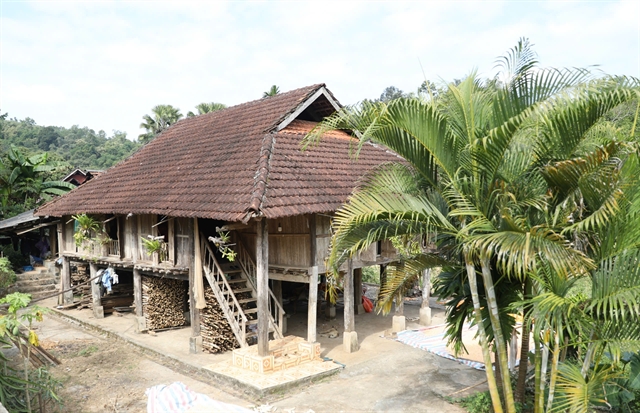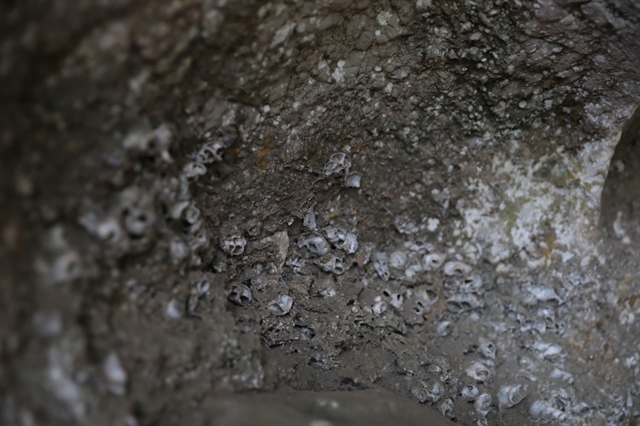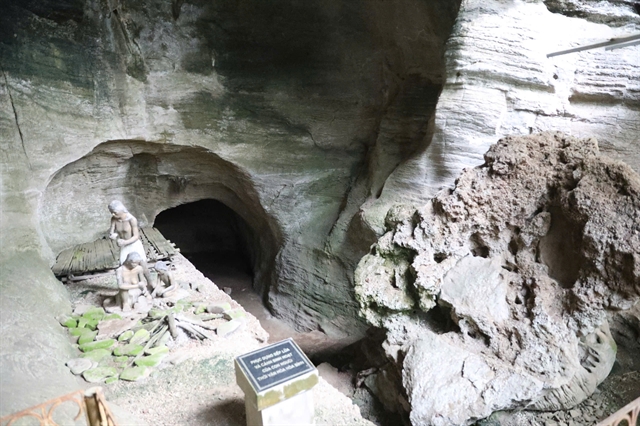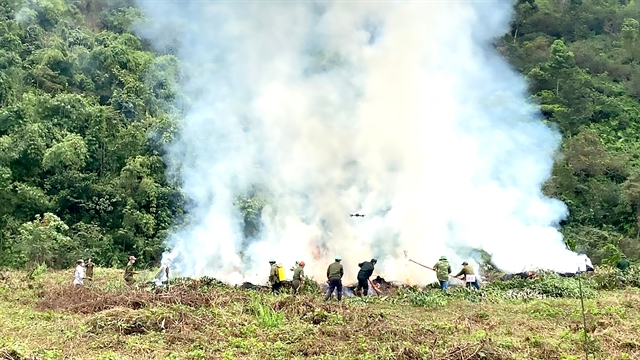 Features
Features

 |
| ANCIENT OUTPOST: Vành Village Cave belongs to the Hòa Bình culture, aged from 8,000 to 17,000 years ago. VNS Photos Đoàn Tùng |
By Trọng Đạt & Lương Hương
Hòa Bình Province in northern Việt Nam is renowned for its rich cultural heritage and multiple archaeological sites that offer a glimpse into the region’s ancient civilisations. Among its most treasured landmarks are Vành Village Cave and Trại Hamlet Cave in Lạc Sơn District, both listed as special national heritage sites.
These caves are central to understanding the Mường culture, which has flourished in the area for thousands of years, and they hold immense potential for cultural tourism.
Vành Village Cave
Located at the foot of the Khụ Vành mountain range in Khụ Vành Hamlet, Yên Phú Commune, Vành Village Cave was first explored in 1929 by French archaeologist M. Colani.
The site features a high, expansive rock overhang that provides natural shelter, with its interior extending 18 metres deep into the mountain. The entrance is littered with mollusc shell fragments, indicating early human activity.
Colani’s 1930 study identified the cave as a significant part of the Hòa Bình culture, which dates back 17,000 to 8,000 years. This culture is considered a cornerstone of Southeast Asia’s prehistory. The Vành Village archaeological site represents a transitional phase in the Stone Age, serving both as a habitation and burial site within the limestone karst region.
Excavations uncovered a wealth of artefacts, including 972 stone tools such as triangular axes, polished implements, pestles, and grinding stones. Other finds included fragments of bones, horns, molluscs, and potteries, as well as traces of cooking and burial practices. Fragments of skulls, charcoal, and burned stones indicate that the site was a hub of daily and ritualistic activities for ancient Hòa Bình communities.
A notable discovery was the abundance of grinding tools—54 blade tools, chisels, perforated stones, and stone rings—all showcasing the advanced craftsmanship of the era.
The cave retains part of its original cultural layer, with Quaternary period sediments visible on its walls, further underscoring its archaeological importance. Vành Village Cave is a vital resource for understanding the life and ingenuity of early human societies in Việt Nam.
Trại Hamlet Cave
 |
| SIGNS OF LIFE: Mollusc shell fragments are found on the walls of Vành Village Cave. |
Situated in Tân Lập Commune, Trại Hamlet Cave is another extraordinary archaeological site, often referred to as the “home” of generations of ancient Mường people. The cave, perched 15 metres above the valley floor, features a wide, arch-like entrance that leads to a spacious interior. The gently sloping floor and natural brightness make it an ideal shelter for prehistoric inhabitants.
The site was discovered in 1975 by Dr Nguyễn Việt, an archaeologist and director of the Centre for Southeast Asian Prehistory, who has since conducted numerous excavations there.
The findings revealed thousands of artefacts within a 4-metre thick cultural layer, including freshwater mollusc shell fragments, coarse pottery shards, and charred rice grains. These discoveries provide the earliest evidence of wet rice agriculture in the Hòa Bình culture, highlighting the advanced agricultural practices of its people.
One of the most significant findings was ancient footpath traces on stone slabs, dating back an astonishing 21,000 years. These are among the oldest such traces in the world and represent a groundbreaking discovery for Southeast Asia.
Archaeologists also uncovered human bones dating back 17,000 years, as well as tools made of stone, bone and horn. A stove constructed from three large stones and remnants of rice husks found at an 80-centimetre depth demonstrate the domestic and culinary sophistication of the ancient Mường people.
Trại Hamlet Cave is notable for its high concentration of artefacts, particularly large stone tools, which reflect a mastery of stone craftsmanship. The site stands as one of the richest repositories of Hòa Bình cultural artefacts, shedding light on the technical and social advancements of the time.
Tourism potential
 |
| GIMME SHELTER: Trại Hamlet Cave has been a home to generations of ancient Mường people. |
Deputy Prime Minister Lê Thành Long on July 18 officially recognised Vành Village Cave and Trại Hamlet Cave as special national heritage. These sites join a growing list of 41 national-level heritage and 30 provincial-level heritage in Hòa Bình Province, including cultural, historical, and scenic sites. The province is steadily becoming a prime destination for heritage tourism.
According to Bùi Xuân Trường, deputy director of the Hòa Bình Department of Culture, Sports and Tourism, these sites are drawing increasing interest from both domestic and international tourists. The province aims to enhance conservation efforts while developing tourism strategies that balance historical exploration, natural preservation, and environmental sustainability.
Local authorities are keen to link these archaeological sites with community-led tourism initiatives.
Phạm Thị Vân Anh, vice chairwoman of the Yên Phú Commune People's Committee, emphasised the importance of preserving Vành Village Cave while promoting its value to boost tourism and local economic growth.
Plans are underway to integrate the site into festival tourism, celebrating the traditions of the ancient Mường people.
During annual festivals, locals and visitors gather at Vành Village Cave to offer incense and pray for favourable weather, abundant harvests, and peace. These cultural events provide a unique opportunity for visitors to connect with the region’s spiritual heritage.
Meanwhile, Tân Lập Commune is leveraging the scenic beauty of the Thung hills surrounding Trại Hamlet Cave to attract tourists.
The Chairman of the Tân Lập Commune People's Committee, Bùi Lý Tưởng, highlighted the area’s potential for offering diverse activities such as exploring Hòa Bình Reservoir, experiencing traditional textile weaving, and participating in annual festivals.
In addition to historical exploration, visitors can enjoy the local cuisine and witness the vibrant customs of the ancient Mường region. These experiences, rooted in both history and natural beauty, promise to leave lasting impressions on tourists. VNS




